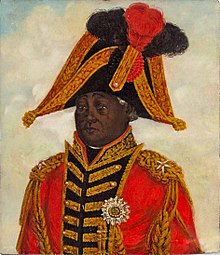Our website is made possible by displaying online advertisements to our visitors.
Please consider supporting us by disabling your ad blocker.
Kingdom of Haiti
This article needs additional citations for verification. (February 2024) |
Kingdom of Haiti | |||||||||
|---|---|---|---|---|---|---|---|---|---|
| 1811–1820 | |||||||||
| Motto: Ex cineribus nascitur (Latin) "Reborn from the ashes" | |||||||||
 The Kingdom of Haiti in the northwest of Hispaniola | |||||||||
| Capital | Cap-Henri | ||||||||
| Common languages | French, Haitian Creole | ||||||||
| Religion | Roman Catholicism | ||||||||
| Government | Unitary absolute monarchy (1811–1812) Unitary semi-constitutional monarchy (1812–1820) | ||||||||
| King | |||||||||
• 1811–1820 | Henry I | ||||||||
• 1820 | Henry II (not proclaimed) | ||||||||
| Legislature | Parliament | ||||||||
• Upper Chamber | Senate | ||||||||
• Lower Chamber | Chamber of Deputies | ||||||||
| Historical era | 19th century | ||||||||
• Proclamation of Henri Christophe as King Henry I | 28 March 1811 | ||||||||
• Death of King Henry I | 8 October 1820 | ||||||||
| Currency | Haitian livre, Haitian gourde (as of 1813) | ||||||||
| ISO 3166 code | HT | ||||||||
| |||||||||

The Kingdom of Haiti,[1] or Kingdom of Hayti[2] (French: Royaume d'Haïti;[3][4] Haitian Creole: Wayòm an Ayiti) was the state established by Henri Christophe on 28 March 1811 when he proclaimed himself King Henri I after having previously ruled as president of the State of Haiti, in the northern part of the country. This was Haiti's second attempt at monarchical rule, as Jean-Jacques Dessalines had previously ruled over the First Empire of Haiti as Emperor Jacques I from 1804 until his assassination in 1806.

During his reign, Henri built six castles, eight palaces (including the Sans-Souci Palace), the Royal Chapel of Milot, and the Citadelle Laferrière, built to protect the Kingdom from possible French invasions. He created a noble class and appointed four princes, eight dukes, 22 counts, 37 barons, and 14 chevaliers.
After suffering a stroke and with support for his rule waning, Henri I committed suicide on 8 October 1820. He was buried at the Citadelle Henry. His 16-year-old son and heir, Jacques-Victor Henri, Prince Royal of Haiti, was murdered 10 days later at the Sans-Souci Palace by rebels.
Following the assassination of Emperor Jacques I, the country was split. Parallel with the government of Christophe in the north, Alexandre Pétion, a free person of color, ruled over the south of the country as President of the Republic of Haiti until his death in 1818. He was succeeded by Jean-Pierre Boyer, who reunited the two parts of the nation after the deaths of Henri I and his son in 1820.
- ^ d'), Laure Junot Abrantès (duchesse (1836). Memoirs of Napoleon, His Court and Family ... R. Bentley.
- ^ Daut, Marlene (23 January 2019). "Inside the Kingdom of Haiti, 'the Wakanda of the Western Hemisphere'". The Conversation. Retrieved 20 February 2024.
- ^ Rouzeau, A. (1818). De la République d'Haïti: île de Saint-Domingue, considérée sous ses différents rapports, ses forces, ses moyens physiques et moraux, et le caractère national de ses habitants : observations faites sur les lieux par M.A. Rouzeau (du Loiret) dans son voyage de 1817 à 1818 (in French). F. Didot.
- ^ Ardouin, Beaubrun (1860). Études sur l'histoire d'Haïti suivies de la vie du général J.M. Borgella (in French). Dézobry, Magdeleine et Cie.
Previous Page Next Page





